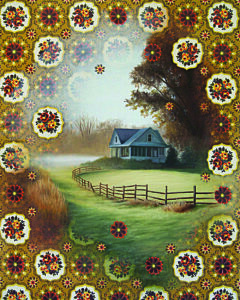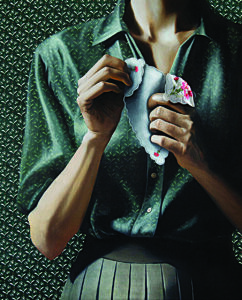Recently the Peoria Art Guild hosted Sydney Swisher, an artist from Newton, who’s inventive imagery develops exquisitely rendered oil paintings on thrifted fabrics. She is a graphic designer adept at computer generated work who began using Artificial Intelligence to create images that are memory laden spaces. They aren’t particularly photographic places, but conjured images she can digitally manipulate before using them as source material for her paintings.
A broken fence surrounding a pastoral lawn and trees leads to a house with a porch without offering a clue whether it is inhabited or not. There is no driveway or garage, lights or people, but there is a palpable sense of timelessness. It’s somewhere, but who knows exactly where? Is it decades old or current? The entire scene is surrounded by patterns found on vintage bed linen, furniture upholstery, or wallpaper. It all fits together seamlessly fading and reappearing like a sheer curtain wafting in a sunlit window, obscuring our view yet facilitating it.
Unlike some artists who print imagery after using AI with Photoshop adjustments, Swisher has the technical skill to create precise images with oil paint. This is what draws us to her art. She could render an interior or landscape that is right in front of her, but because the imagery is a facsimile, it seems strange and yet familiar.
Her anachronistic pictures buck the trend in much work generated by AI.
Swisher uses a program such as Mid-journey to generate images from text prompts that she can augment, change, redesign and hone. The pictures are from the wealth of depictions on the internet, but are not specific to place or person. They hover somewhere between what is already in the world and an idealized sense of it. Not created by one person, but by a kind of collective intelligence.
She has been inspired by photographers Greg Crewdson and Todd Hido, who both create work deeply rooted in the American experience founded in our small towns and interior living spaces. They present a kind of solemn and quiet world that holds mystery and a sense of the unreality of the everyday. The American painter Edward Hopper and his paintings of light-drenched midwestern homes also fit this aesthetic. When Swisher uses human subjects, she avoids the intimacy of identifying them, revealing only a hand and garments that are personally indistinguishable.
Complementary with the finely crafted painted handkerchief, beads or curtain, Swisher adds fabric and beads as real items onto her paintings. It is remarkable that at first glance one may not distinguish between the painted form and the actual object. She adds yet another layer of real versus ideal, of imagination in contrast to the real.
Swisher’s work points to a relationship with our insistent use of computers that is more a partnership than robotic intelligence. She is the master of the images she creates, not at the mercy of being so intrigued by what strangeness can be generated that she loses sight of a connection to what is around us. Her work shows us how we can live with what we are not getting away from any time soon, our world of iPhones, Androids and computer generated content.
Website SydneySwisher.com Instagram @Sydswisher TikTok. @Sydswisher Facebook Sydney Swisher





Recent Comments